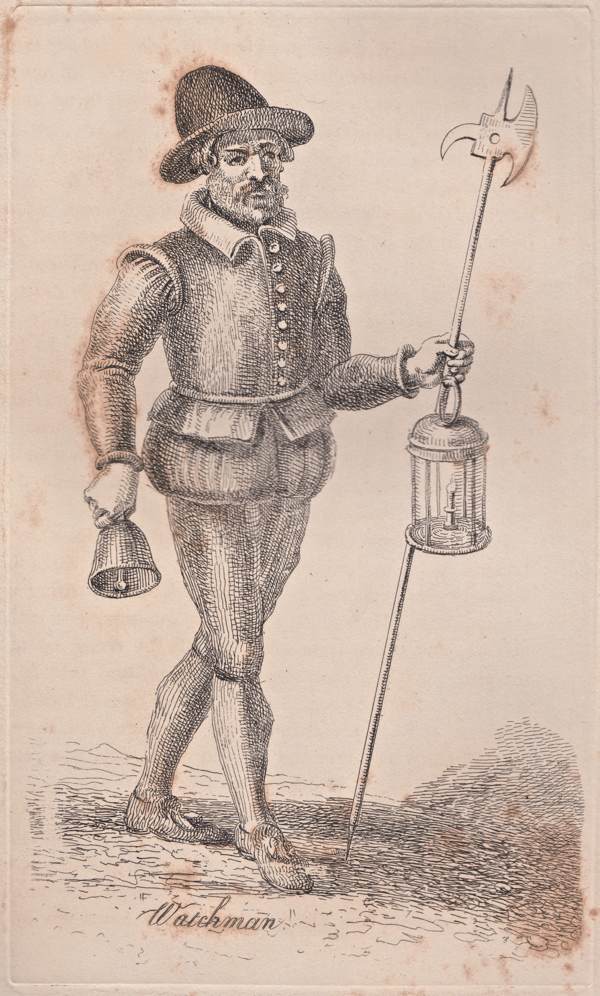William Anthony, Last Of the Charlies

William Anthony 1789-1863
Behold the face of history! Photographed in 1863, the year of his death, but born in 1789, the year of the French Revolution, seventy-four-year-old William Anthony trudged the streets of Spitalfields and Norton Folgate through the darkest nights and thickest fogs for half a century, with his nose pointed into the wind and his jaw set in determination, successfully guided by a terrier-like instinct to seek out miscreants and prevent the outbreak of any unholy excesses of violence, such as erupted on the other side of the channel at the time of his nascence.
No wonder the Watch Book of Norton Folgate recorded an unbroken sequence of “All’s Well” for his entire tenure. No robbery was reported in fifty years. There was no nonsense with William Anthony. We need him at night on Brick Lane today.
The origin of the term ‘Charley’ for Watchman may originate in the time of Charles I when the monarch improved the watch system, although Jonathon Green, Spitalfields Life Contributing Lexicographer of Slang, who informed me of this possible derivation, can find no subsequent use in print for another one hundred and fifty years, when the term achieved currency in the early nineteenth century.
‘Charley’ as a derogatory term for a foolish person has survived into modern times, yet – as these photographs attest – William Anthony was unapologetic, quite content to be a ‘Charley.’ Behind him stand a long line of ‘Charlies’ stretching back through time for as long as London has existed and I think we may discern a certain dogged pride in William Anthony’s bearing, clutching his dark lantern in one hand and knobbly staff of office in the other, swaddled up in a great coat against the cold, wrapped in an apron against the filth, shod in sturdy boots against the damp and sheltered under his stout hat from the downpour.
Now I know his appearance, I will look out for William Anthony, lest our paths cross in the wintry dusk in Blossom St or Elder St – others might disregard him as another homeless old man walking all night but I shall hail him and pay my respects to the last of the ‘Charlies.’ He is the one of whom you could truly say you would be glad to meet him in a dark alley at night.



In Norton Folgate, the Watchman recorded an unbroken sequence of “All’s Well”

Tom & Jerry “getting the best of a Charley” at Temple Bar engraved by George Cruickshank, 1832

“Past one o’clock and a fine morning!” from Thomas Rowlandson’s ‘Lower Orders’

The Watchman, 1819 from ‘Pictures of Real Life for Children’

“Past Twelve O’Clock and A Cloudy Morning! & Patrol! Patrol!” from ‘Sam Syntax’s Cries of London’
 “Past twelve o’clock and a misty morning! Past twelve o’clock and mind I give you warning!” published by Charles Hindley, Leadenhall Press, 1884
“Past twelve o’clock and a misty morning! Past twelve o’clock and mind I give you warning!” published by Charles Hindley, Leadenhall Press, 1884

Watchman by John Thomas Smith, copied from a print prefixed to ‘Villanies discovered by Lanthorne and Candlelight’ by Thomas Dekker 1616. “The marching Watch contained in number two thousand men, part of them being old souldiers, of skill to be captaines, lieutenants, serjeants, corporals &c. The poore men taking wages, besides that every one had a strawne hat, with no badge painted, and his breakfast in the morning.”
Images courtesy Bishopsgate Institute
You may also like to read about

















I loved this – so interesting … thanks GA …
I am curious about his need to wear an apron in the job?
‘Charley’ as a derogatory term for a foolish person has survived into modern times’
Up to a point, Lord Copper. Charlie as a fool (esp. as ‘a proper charlie’) is first found in 1946 and is rhyming slang: ‘charlie hunt’ = ‘cunt’ (as fool rather than vagina). There is a single earlier instance, from Australia in 1914: ‘This same German sausage Charley / As was living down the street’ but in truth, its hard to know if this is ‘our’ charlie or not.
Charlie = watchman also well known for the cruel prank played by upper-class hooligans around 1800: ‘boxing a charlie’: trapping the watchman in his box and turning it over, with the door secured shut by the street beneath
The white of the apron would also have reflected the light from the lantern. The status of the carrier would have been known then.
When I was at Primary school in Pimlico in the late ’50’s, if a petticoat was visible beneath the hem of a skirt, the cry went up of ‘Charlie’s dead’. I have no idea why.
for Geraldine Beskin. I was at primary school in Lincoln at same time. We too used ‘Charlie’s dead’ in the same circumstances. I didn’t know why then, I haven’t found out since. First e.g. in my own dictionary is in an American reference work of 1942. Plot thickens.